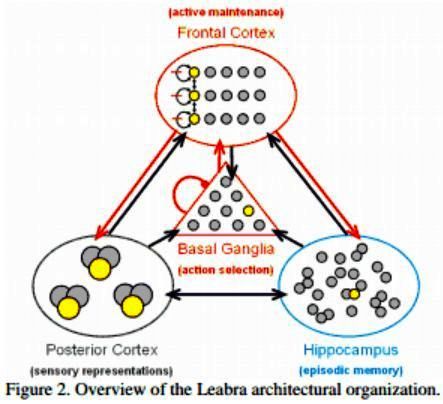 LEABRA (Local, Error-driven, Associative, Biologically Realistic Algorithm) cognitive architecture, developed under Randall C. O'Reilly at the University of Colorado at Boulder, CO, USA and David C. Noelle at the University of California, Merced, CA, USA.
LEABRA (Local, Error-driven, Associative, Biologically Realistic Algorithm) cognitive architecture, developed under Randall C. O'Reilly at the University of Colorado at Boulder, CO, USA and David C. Noelle at the University of California, Merced, CA, USA.
LEABRA Page | Randall C. O'Reilly's Home Page
Email: Этот адрес электронной почты защищён от спам-ботов. У вас должен быть включен JavaScript для просмотра. ![]()
Рандел C. О’Рейли - один из основных разработчиков когнитивных архитектур эмерджентного типа (Emergent neural network simulation software), его публикации можно найти на сайте Randy O'Reilly's website.
Общие сведения
Leabra is a neural modeling architecture.
Leabra is a set of algorithms for simulating neural networks (O’Reilly and Munakata 2000) which combine into an integrative theory of brain (and cognitive) function.
These algorithms serve as a computational theory of brain function (primarily cortical), as the algorithms and their parameterization have been closely guided by a wide variety of data.
Leabra operates at an intermediate level of detail (e.g., firing-rate coded, point neurons) to allow modeling effects both down to the molecular effects (e.g., increased sodium conductances from pharmacological manipulation) and up to the cognitive level (e.g., differentially worse performance in the incongruent condition of the Stroop task).


Source: http://psych.colorado.edu/~oreilly/
Leabra network models
Currently implemented as a Leabra network is a model of the visual system (Leabra Vision – Lvis; O’Reilly et al. 2013) which is used to identify object attributes. In this iteration, this recurrent multi-layer neural network model has been trained and is currently employed to identify object color, leaving much unexploited potential to be explored in later iterations. As mentioned above, more complex perceptual processes and motor processes are envisioned to be implemented as neural network models at some point.
Publications
Публикации Рандела C. О’Рейли можно найти на сайте Randy O'Reilly's website.
1. Integrating Systems and Theories in the SAL Hybrid Architecture. Andrew Szabados1, Seth Herd2, Yury Vinokurov, Christian Lebiere, Randall C. O’Reilly (pdf)



